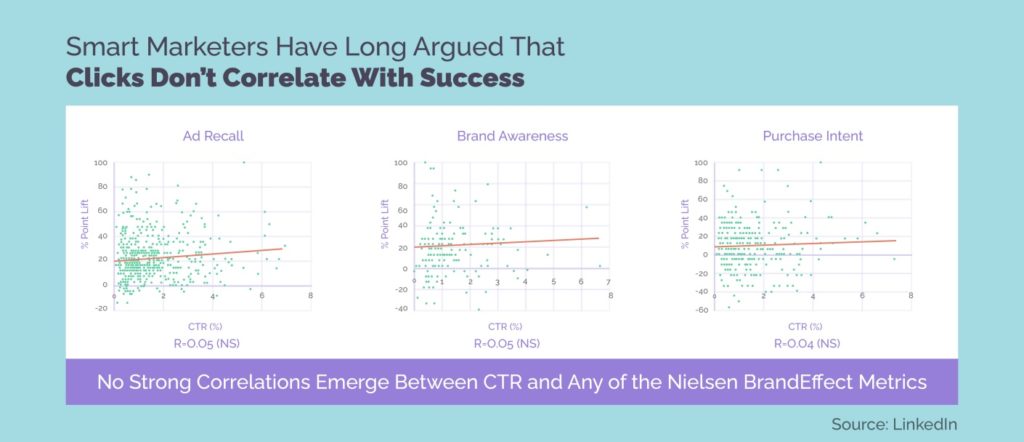Here’s a hard truth: as convenient as click-through rate is for marketers to measure, it isn’t actually a reliable indicator of success or failure.
So why has it been held up as such a critical KPI?
There are a couple of reasons—but the simplest one is that it’s easy. You can see your click-through rate on any analytics program and quickly draw conclusions: a high rate means a high rate of success, and low means a low one. Right?
Not quite.
So if click-through rate doesn’t matter nearly as much as we all thought it did, what should we be focusing on instead?
Let’s take a look.
First, why doesn’t click-through rate matter?
The issue with looking at click-through rates is this:
Research has shown that high click-through rates can not only be a negative indicator but that the ads that do produce the greatest results (in terms of awareness, purchase intent, and recall) are almost never the ones that generate the most clicks.

As the LinkedIn article cited above says, there is a term for stuff that gets a whole lot of clicks: clickbait.
And no reputable brand wants to be putting out clickbait. What’s more, it turns out that a huge percentage of ad clicks on the internet are from bots, not actual people. That further dilutes the power of click-through rate as an indicator of, well—anything.
Now, you may be saying to yourself that your brand already knows this. You don’t focus on click-through rates (CTR) as much as engagement and conversions.
That may be true in theory, but how many times has your marketing team reported on CTR to your COO or CFO—despite knowing that it doesn’t mean much?
There’s a lot of pressure, in other words, to focus on CTR as a metric. Breaking the cycle requires not only showing why CTR doesn’t mean what we think it does, but also presenting KPIs and metrics that actually are solid indicators of a marketing tactic’s success or failure.
With that in mind, let’s look at two of the KPIs that matter the most for brand marketers: share of voice and brand reach.
What is share of voice (SOV)?
Share of voice can seem like a complicated concept, but it’s actually fairly straightforward. It’s the share of your particular market that your brand owns.
Pre-internet, that would equate to the total amount of advertising your brand owned compared to that of all your competitors combined.
Today, share of voice includes not only paid advertising, but also awareness as measured through site traffic, social media mentions, and PR hits.
Taken together, these numbers can give you a fairly clear idea of where your brand stands.
Why does share of voice matter?
This is why share of voice matters now more than ever before:
Your B2B brand is now competing not just with other companies in your market. You’re competing with every other brand that your customers see on their social feeds, their search engine results pages, and on their news feeds.
And as they’re scrolling past social ad after social ad, your share of voice is what gets them to stop for more than a fraction of a second and pay attention to your brand.
So it’s clear that without a significant share of voice, your brand won’t be able to break through the online noise and reach new customers.
When you know your share of voice, you’ll also be able to figure out in practical terms:
- Which platforms you’re performing well on
- Which platforms aren’t worth your time or need to be significantly improved
- How well a marketing campaign did—whether or not it increased your share of voice
- Your ROI from a particular digital campaign
- Which paid ad campaigns are working and which aren’t
You can read a comprehensive post on share of voice and how to calculate it here.
What is brand reach?
Brand reach is the total number of people who see your content, regardless of whether or not they engage with it. Simple as that.
Why does brand reach matter?
In the digital marketing world we live in, engagement is typically a brand’s top goal. Engagement certainly should be a primary goal—but as the research from LinkedIn shows, ads actually do not have to generate engagements in order to be effective.
In fact, most of the people you want to reach—discerning, professional B2B buyers—hardly ever click on ads.
Think about it: when was the last time you clicked on one? You may see the ad, register the brand’s name, maybe visit the brand’s website later to check them out, but you likely don’t click on many, if any, ads.
It’s the exposure that’s working in this case, even though you’re not engaging with the ad in a measurable way.
Consider that before digital advertising and social media, all advertising was a matter of exposure rather than engagements. TV commercials, subway ads, billboards, radio ads—consumers don’t engage with any of it, but it still works.
All this is to say that brand reach actually matters more than we think it does. It matters even more now because B2B buyers are not only completing most of the buyer journey before ever engaging with a salesperson but also requiring approximately 27 interactions with a brand before they become a customer.
Most of those interactions are going to be unmeasurable and even unknown to your brand. They occur when a potential buyer, for example:
- Sees a post by your executive on social
- Sees an ad for your new product as they’re browsing online for something else
- Reads a feature that mentions your brand on a media website
This, by the way, is why B2B PR has also become more important for B2B in the past few years, and especially since 2020, when the average number of brand interactions required to take someone from prospect to customer jumped by 10.
Here’s the big takeaway: If you’re looking for metrics that really mean something, brand reach and share of voice are the ones to focus on. CTR is easy and convenient to track, but ultimately it’s a terrible indicator of either campaign success or failure.
It’s a paradigm shift, no doubt. If you need some help getting there, give us a call.







